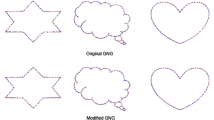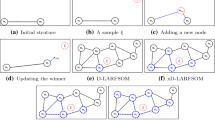Abstract
This work introduces a method that produces triangular mesh representation of a target object surface. The new surface reconstruction method is based on Growing Self-organizing Maps, which learns both the geometry and the topology of the input data set. Each map grows incrementally producing meshes of different resolutions, according to different application needs. Experimental results show that the proposed method can produce triangular meshes having approximately equilateral faces, that approximate very well the shape of an object, including its concave regions and holes, if any.
Preview
Unable to display preview. Download preview PDF.
Similar content being viewed by others
References
Hoppe, H., Derose, T., Duchamp, T., Mcdonald, J., Stuetzle, W.: Surface reconstruction from unorganized points. In: Proceedings of Siggraph Conference, pp. 71–78 (1992)
Amenta, N., Bern, M., Kamvysselis, M.: A new voronoi-based surface reconstruction algorithm. In: Siggraph Conference Proceedings, pp. 415–422 (1998)
Miller, J., Breen, D., Lorensent, W., O’Bara, R., Wozny, M.: Geometrically deformed models: A method for extracting closed geometric models from volume data. In: Proceedings of the International Conference on Computer Graphics and Interactive Techniques, vol. 25, pp. 217–226 (1991)
Qin, H., Mandal, C., Vemuri, B.: Dynamic catmull-clark subdivision surfaces. IEEE Transactions on Visualization and Computer Graphics 4(3), 215–229 (1998)
Hoffmann, M., Varady, L.: Free-form modelling surfaces for scattered data by neural networks. Journal for Geometry and Graphics 2(1), 1–6 (1998)
Brito, A., Doria, A., de Melo, J., Goncalves, L.: An adaptive learning approach for 3d surface reconstruction from point clouds. IEEE Transactions on Neural Networks 19(6), 1130–1140 (2008)
Yu, Y.: Surface reconstruction from unorganized points using self-organizing neural networks. In: Proceedings of IEEE Visualization Conference, pp. 61–64 (1999)
do Rego, R.L.M.E., Araujo, A.F.R., de Lima Neto, F.B.: Growing self-organizing maps for surface reconstruction from unstructured point clouds. In: International Joint Conference on Neural Networks, pp. 1900–1905 (2007)
Kohonen, T.: Self-Organizing Maps. Springer, Berlin (2001)
Fritzke, B.: Unsupervised ontogenetic networks. Handbook of Neural Computation (1996)
Barhak, J.: Freeform objects with arbitrary topology from multirange images. PhD thesis, Institute of Technology, Haifa, Israel (2002)
Martinetz, T., Schulten, K.: Topology representing networks. Neural Netw. 7(3), 507–522 (1994)
Ivrissimtzis, I., Jeong, W.K., Seidel, H.P.: Using growing cell structures for surface reconstruction. In: Proceedings of International Conference on Adaptive and Natural Computing Algorithms, pp. 78–86 (2003)
Fritzke, B.: Growing cell structures - a self-organizing network for unsupervised and supervied learning. Neural Networks 7, 9–13 (1994)
Martinetz, T.M., Schulten, K.J.: A neural-gas network learns topologies. Artificial Neural Networks, 397–402 (1991)
DalleMole, V., Araujo, A.F.R.: The growing self-organizing surface map. In: International Joint Conference on Neural Networks, pp. 2061–2068 (2008)
Saleem, W.: A flexible framework for learning-based surface reconstruction. Master’s thesis, Computer Science Departament, University of Saarland, Saabrucken, Germany (2003)
Amenta, N., Choi, S., Kolluri, R.K.: The power crust. In: Proceedings of the sixth ACM symposium on Solid modeling and applications, pp. 249–266 (2001)
Author information
Authors and Affiliations
Editor information
Editors and Affiliations
Rights and permissions
Copyright information
© 2009 Springer-Verlag Berlin Heidelberg
About this paper
Cite this paper
do Rego, R.L.M.E., Bassani, H.F., Filgueiras, D., Araujo, A.F.R. (2009). Surface Reconstruction Method Based on a Growing Self-Organizing Map. In: Alippi, C., Polycarpou, M., Panayiotou, C., Ellinas, G. (eds) Artificial Neural Networks – ICANN 2009. ICANN 2009. Lecture Notes in Computer Science, vol 5768. Springer, Berlin, Heidelberg. https://doi.org/10.1007/978-3-642-04274-4_54
Download citation
DOI: https://doi.org/10.1007/978-3-642-04274-4_54
Publisher Name: Springer, Berlin, Heidelberg
Print ISBN: 978-3-642-04273-7
Online ISBN: 978-3-642-04274-4
eBook Packages: Computer ScienceComputer Science (R0)




